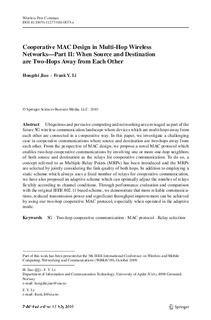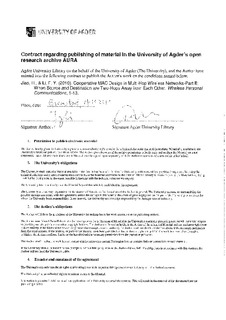| dc.contributor.author | Jiao, Hongzhi | |
| dc.contributor.author | Li, Frank Yong | |
| dc.date.accessioned | 2010-11-10T09:16:25Z | |
| dc.date.available | 2010-11-10T09:16:25Z | |
| dc.date.issued | 2010 | |
| dc.identifier.citation | Jiao, H., & Li, F. Y. (2010). Cooperative MAC Design in Multi-Hop Wireless Networks-Part II: When Source and Destination are Two-Hops Away from Each Other. Wireless Personal Communications, 1-13. doi: 10.1007/s11277-010-0073-x | en_US |
| dc.identifier.issn | 0929-6212 | |
| dc.identifier.uri | http://hdl.handle.net/11250/137784 | |
| dc.description | Published version of an article from the journal: Wireless Personal Communications. The original publication is available at Spingerlink. http://dx.doi.org/10.1007/s11277-010-0073-x | en_US |
| dc.description.abstract | Ubiquitous and pervasive computing and networking are envisaged as part of the future 5G wireless communication landscape where devices which are multi-hops away from each other are connected in a cooperative way. In this paper, we investigate a challenging case in cooperative communications where source and destination are two-hops away from each other. From the perspective of MAC design, we propose a novel MAC protocol which enables two-hop cooperative communications by involving one or more one-hop neighbors of both source and destination as the relays for cooperative communication. To do so, a concept referred to as Multiple Relay Points (MRPs) has been introduced and the MRPs are selected by jointly considering the link quality of both hops. In addition to employing a static scheme which always uses a fixed number of relays for cooperative communication, we have also proposed an adaptive scheme which can optimally adjust the number of relays flexibly according to channel conditions. Through performance evaluation and comparison with the original IEEE 802.11 based scheme, we demonstrate that more reliable communications, reduced transmission power and significant throughput improvement can be achieved by using our two-hop cooperative MAC protocol, especially when operated in the adaptive mode. © 2010 Springer Science+Business Media, LLC. | en_US |
| dc.language.iso | eng | en_US |
| dc.publisher | Springer | en_US |
| dc.title | Cooperative MAC design in multi-hop wireless networks-Part II: When source and destination are two-hops away from each other | en_US |
| dc.type | Journal article | en_US |
| dc.type | Peer reviewed | en_US |
| dc.subject.nsi | VDP::Technology: 500::Information and communication technology: 550::Telecommunication: 552 | en_US |
| dc.subject.nsi | VDP::Mathematics and natural science: 400::Information and communication science: 420::Communication and distributed systems: 423 | en_US |
| dc.source.pagenumber | 1-13 | en_US |

